While every home is undoubtedly unique, American and British interior design styles are distinguished by a few defining characteristics. And while subtle clues can be found in almost any space, the differences are more noticeable in certain rooms than others.
The difference between British and American interior styles can be clearly seen in the kitchen. In the kitchen, the chosen aesthetic influences everything from storage to natural light. As our world has become more interconnected, styles have gradually merged, but certain traits still stand out as one or the other.
To better understand the differences between the two kitchen styles, we spoke to American and British interior designers to share the top eight differences they saw. Here's what they had to say:
8 differences between American and British kitchens according to a designer
Like British kitchens, American kitchens vary greatly in style. Although this diversity cannot be ignored, several characteristics distinguish the larger group. These are the nine differences the designer says define his two kitchen styles.
1. Layout
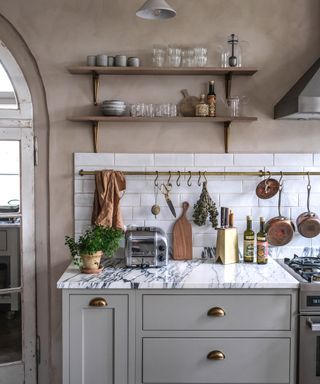
(Image courtesy of deVOL Kitchens)
American homes are not necessarily larger than British homes, but British kitchens tend to be more compact and feature-rich. British kitchens, often found in more historic buildings, often offer a masterclass in smart storage and designing form according to function.
Interior designer Audrey Scheck, founder of Austin, Texas-based Audrey Scheck Design, says British kitchens “typically make the most of every inch of space within a small footprint.” .
'[In British kitchens], you'll often find a compact and efficient layout where everything is within easy reach. American kitchens tend to be more spacious, with open floor plans that flow seamlessly into the living or dining area. They are often intended for entertaining and feature spacious countertops or islands for food preparation and socializing,” she says.
From open-plan kitchens to open storage, American spaces tend to take advantage of more spacious environments, and kitchens often blend in with the rest of the home. By combining the dining room and/or living room, the entire home flows together and entertaining and entertaining naturally occurs in this space.
2. Atmosphere
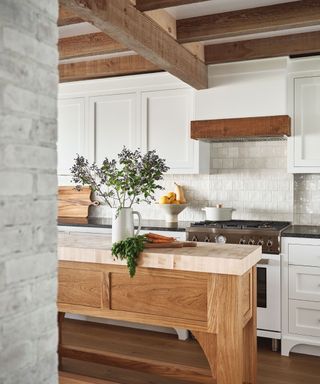
(Image credit: Van Sarki / Bevan Interiors)
Layout is one of the many factors that influence the overall feel and aesthetic of both British and American kitchens. When it comes to beauty, Mike Whitfield, head of sales at UK-based luxury homewares brand Lusso, says it's a “firm favorite in both the UK and the US”.
“Neutral colors and natural materials are popular in both countries, but there are differences in the sources of inspiration. In the US, mid-century modern kitchens and bohemian styles are favored; in the UK, more traditional We’re seeing touches of farmhouse style and cottagecore more often,” he says.
While there are definitely farmhouse kitchen ideas in the US and sleek modern kitchen ideas in the UK, these general trends have influenced homes through decades of interior design. I'm here. The way the space feels is also different.
“British kitchens can look more eclectic and imperfect, which gives them a warm and casual feel. American kitchens, on the other hand, are very clean and feel seamlessly managed. ” says Mike.
Interior designer Kimberly Bevan, founder of Bevan Interiors, grew up in England and currently designs spaces in New York City and the Catskills region. She curates homes for American clients, drawing inspiration from her experiences growing up in the English countryside. And Kimberly agrees that this “eclectic” design sense changes the experience of living in the space.
“Growing up in England, I remember the kitchens in British homes feeling less like kitchens and more like second living rooms in the sense that the finishes didn't scream 'kitchen',” she says. says.
3. Home appliances
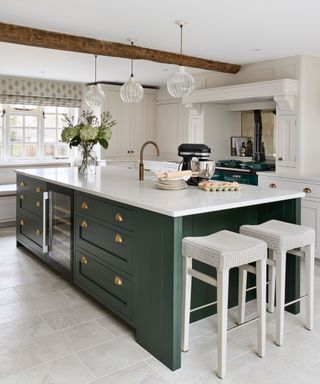
(Image credit: Davonport)
Due to size and layout, the appliances found in American and British kitchens also differ. It's not just the brand name, but Kimberly says there are certain appliances that stand out as European.
“When I think of British kitchens, I immediately think of AGA ranges with constant radiant heat that can heat an entire room. It also has a warming drawer, so it’s also perfect for warming socks and gloves on cold days. ” she says.
Boundary and impressive, the AGA range cooker truly defines a space and is often the center of attention in UK kitchens. But apart from high-quality range cookers, British kitchens tend to avoid large or eye-catching appliances.
“In the UK, kitchens are usually filled with small appliances due to space constraints. American kitchens have a lot more to play with, such as refrigerators with ice makers and water dispensers, oversized ranges and They are often equipped with large appliances such as countertops and high-capacity dishwashers,” says Mike.
From dishwashers to countertop toasters, American kitchens tend to have a greater variety of appliances throughout the space. And while Mike says the extra space gives him a lot of room to play and experiment with appliances, he's still careful about how those appliances fit into the overall aesthetic. I added that I need to pay.
4. Storage
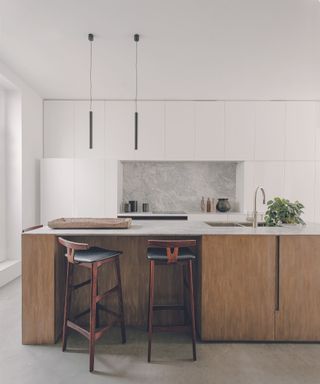
(Image credit: Future)
“Instead of the built-in cabinets and predictable center islands that we're used to in American kitchens, British kitchen storage is more independent,” says Kimberly.
For both functionality and aesthetic purposes, British kitchen design is much more contained than open-air. Kimberly said sheds and sideboards replace “long rows of cabinets,” and butcher block and kitchen tables often replace kitchen islands. She added, “The stove can be used not only for cooking, but also as a place to gather and warm up.”
Mike agrees, saying that “smart storage solutions” such as “pull-out shelving, tall pantry cabinets and corner storage units” are popular as “space efficiency is prioritized” in British kitchens. Ta.
But those practices are starting to change, Kimberly says. She says that while kitchen islands are moving en masse from the US to the UK, quintessentially British storage solutions are starting to appear more and more in the US. What are the additional benefits of this transition? She says of the interior design possibilities within the pantry space.
“Traditionally a British staple, the pantry room is becoming very popular in American homes as well. Even a small room can give a personality that sets it apart from the rest of the house, so it's best to add wallpaper or add a bold touch to the room. It’s a great opportunity to paint with color,” says Kimberly.
5. Design
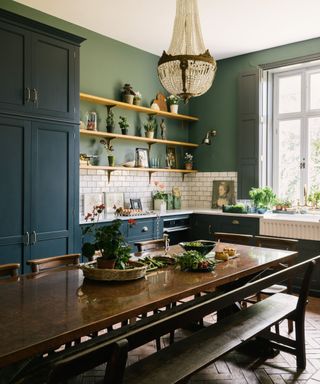
(Image courtesy of deVOL Kitchens)
“British kitchens have a charm not found anywhere else in the world. This is especially true in period properties. Kitchens in these homes are often bespoke and, if done well, can be traditional aesthetics with high-end, luxurious finishes for a beautiful, eclectic style,” says Mike.
Our bespoke English kitchens feature timeless design and thoughtful planning. The effort that goes into our handcrafted cabinets and thoughtful design tailored to each space will last forever. And it's the intangible quality this idea brings to a space that makes British kitchens so undeniably unique.
Richard Davonport, managing director of UK-based bespoke kitchen furniture brand Davonport Kitchens, says this attention to detail has influenced many of the design features that distinguish British kitchens. It says that there is.
“In the UK, bespoke kitchens tend to veer towards the classic and timeless, with wood particularly favored at the moment with hand-painted cabinets and worktops such as marble, granite and quartz. ” says Richard.
On the other hand, American kitchens have their own charm, leaning toward more modern kitchen finishes, “such as polished cabinets and stainless steel.” “However, in recent years, the lines have become noticeably blurred, albeit glossy,” he says. Stainless steel is also trending, so the US is importing kitchen trends to the UK,” Richard added.
6. Lighting
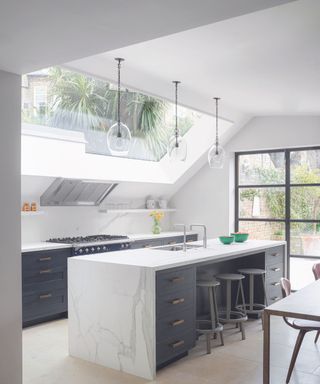
(Image credit: Future)
American kitchens tend to have a lot to work with when it comes to kitchen lighting ideas. Although those who live in Midwestern states or on the East Coast may disagree, Mike says many states in the U.S. have “great weather,” making indoor-outdoor designs easy to achieve. That's what it means. He said the “option with floor-to-ceiling garden access” was “perfect for family living”, but that was not always possible in buildings in the UK.
“Lighting in British kitchens can be difficult to get right. Natural light can't always be relied on, and while you need bright lighting for meal preparation, it still needs to be a livable space.'' “Finding the right balance of lighting is a challenge that can infringe on the style of a British kitchen,” he says.
And even though American kitchens generally benefit from natural light, Kimberly says they're slowly getting more creative with their lighting. She sees American kitchens catching up to the considered lighting plans of British kitchens, which compensate for the lack of natural light.
“Instead of a row of identical pendant lights above an island, I often incorporate table lamps and one-off pendants above the butcher or kitchen table,” she says.
7. Drink station
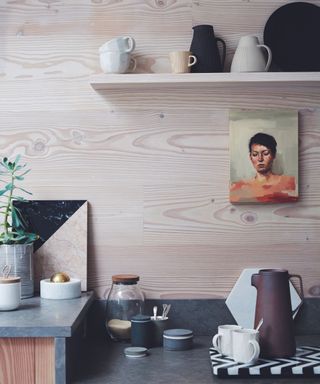
(Image credit: Future)
Although the need for caffeine is universal, Britain's love of tea is not reflected in each state, and this difference is evident in many kitchens. Over time, British drinks stations have migrated to the United States, where we seem to be having a moment of coffee stations inspired by, but not identical to, British design.
“Having a pot of tea or coffee always available feels very British, and inspired the designated coffee bars in American kitchens.” These coffee bars can be used at any time of the day. It’s a dedicated area in the kitchen for making coffee,” says Kimberly.
Richard says drinks stations, and particularly kettles, are “traditional British elements” and ultimately “top everyone's list of things they want to own at some point”.
“This includes the classic and iconic AGA, and our love of kettles. Hot taps are definitely growing in popularity, but for most of us, even though we have a coffee machine, a kettle is the only thing in the kitchen. “Americans aren't really into tea, so there's almost always coffee and a coffee machine in the kitchen,” he says.
8. Shelf
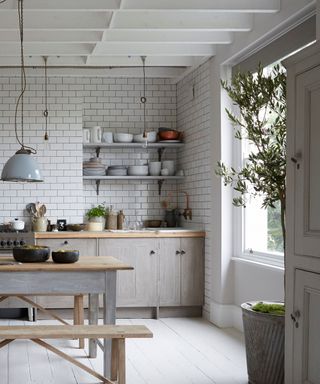
(Image credit: Future)
Open or floating kitchen shelves are a feature of classic British kitchens, and Kimberly says this look is starting to make its way to the United States. Placing open shelving in the kitchen allows plates and mugs to coexist with 'non-kitchen objects', contributing to the collected, lived-in look that many British kitchens evoke.
“I love seeing artwork, books, mirrors, and other collectibles juxtaposed with everyday kitchen items. Incorporating these elements really makes a room feel cozy and loved. It feels like,” Kimberly says.
Similarly, in British kitchens, plates are often hung on the wall as decoration rather than hidden in cupboards. Pots and pans are often seen hanging from the ceiling or walls, and convenient bars are often mounted on the wall for storage of kitchen utensils.
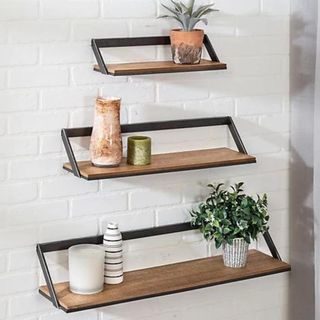
decorative metal and wooden wall shelves
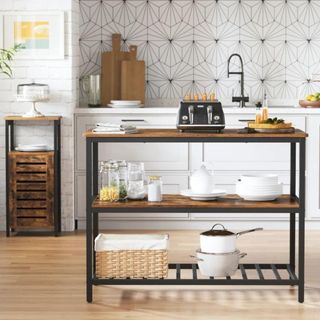
Wrigglewood Kitchen Island
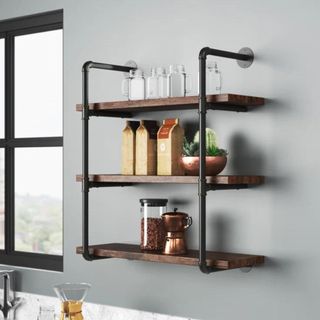
Hathorn 3 Piece Tiered Shelf
American and British kitchen design styles overlap more and more over time, but each has its own unique personality, aesthetic, and feel. If you want to combine two styles, doing so is now easier than ever. You don't need another reason to invest in AGA.


